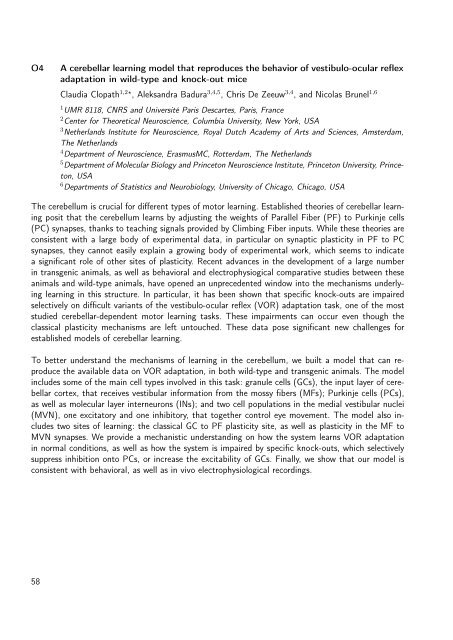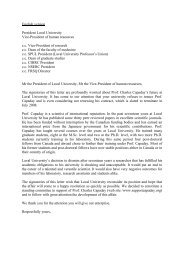Untitled - Laboratory of Neurophysics and Physiology
Untitled - Laboratory of Neurophysics and Physiology
Untitled - Laboratory of Neurophysics and Physiology
Create successful ePaper yourself
Turn your PDF publications into a flip-book with our unique Google optimized e-Paper software.
O4<br />
A cerebellar learning model that reproduces the behavior <strong>of</strong> vestibulo-ocular reflex<br />
adaptation in wild-type <strong>and</strong> knock-out mice<br />
Claudia Clopath 1,2⋆ , Aleks<strong>and</strong>ra Badura 3,4,5 , Chris De Zeeuw 3,4 , <strong>and</strong> Nicolas Brunel 1,6<br />
1 UMR 8118, CNRS <strong>and</strong> Université Paris Descartes, Paris, France<br />
2 Center for Theoretical Neuroscience, Columbia University, New York, USA<br />
3 Netherl<strong>and</strong>s Institute for Neuroscience, Royal Dutch Academy <strong>of</strong> Arts <strong>and</strong> Sciences, Amsterdam,<br />
The Netherl<strong>and</strong>s<br />
4 Department <strong>of</strong> Neuroscience, ErasmusMC, Rotterdam, The Netherl<strong>and</strong>s<br />
5 Department <strong>of</strong> Molecular Biology <strong>and</strong> Princeton Neuroscience Institute, Princeton University, Princeton,<br />
USA<br />
6 Departments <strong>of</strong> Statistics <strong>and</strong> Neurobiology, University <strong>of</strong> Chicago, Chicago, USA<br />
The cerebellum is crucial for different types <strong>of</strong> motor learning. Established theories <strong>of</strong> cerebellar learning<br />
posit that the cerebellum learns by adjusting the weights <strong>of</strong> Parallel Fiber (PF) to Purkinje cells<br />
(PC) synapses, thanks to teaching signals provided by Climbing Fiber inputs. While these theories are<br />
consistent with a large body <strong>of</strong> experimental data, in particular on synaptic plasticity in PF to PC<br />
synapses, they cannot easily explain a growing body <strong>of</strong> experimental work, which seems to indicate<br />
a significant role <strong>of</strong> other sites <strong>of</strong> plasticity. Recent advances in the development <strong>of</strong> a large number<br />
in transgenic animals, as well as behavioral <strong>and</strong> electrophysiogical comparative studies between these<br />
animals <strong>and</strong> wild-type animals, have opened an unprecedented window into the mechanisms underlying<br />
learning in this structure. In particular, it has been shown that specific knock-outs are impaired<br />
selectively on difficult variants <strong>of</strong> the vestibulo-ocular reflex (VOR) adaptation task, one <strong>of</strong> the most<br />
studied cerebellar-dependent motor learning tasks. These impairments can occur even though the<br />
classical plasticity mechanisms are left untouched. These data pose significant new challenges for<br />
established models <strong>of</strong> cerebellar learning.<br />
To better underst<strong>and</strong> the mechanisms <strong>of</strong> learning in the cerebellum, we built a model that can reproduce<br />
the available data on VOR adaptation, in both wild-type <strong>and</strong> transgenic animals. The model<br />
includes some <strong>of</strong> the main cell types involved in this task: granule cells (GCs), the input layer <strong>of</strong> cerebellar<br />
cortex, that receives vestibular information from the mossy fibers (MFs); Purkinje cells (PCs),<br />
as well as molecular layer interneurons (INs); <strong>and</strong> two cell populations in the medial vestibular nuclei<br />
(MVN), one excitatory <strong>and</strong> one inhibitory, that together control eye movement. The model also includes<br />
two sites <strong>of</strong> learning: the classical GC to PF plasticity site, as well as plasticity in the MF to<br />
MVN synapses. We provide a mechanistic underst<strong>and</strong>ing on how the system learns VOR adaptation<br />
in normal conditions, as well as how the system is impaired by specific knock-outs, which selectively<br />
suppress inhibition onto PCs, or increase the excitability <strong>of</strong> GCs. Finally, we show that our model is<br />
consistent with behavioral, as well as in vivo electrophysiological recordings.<br />
58



